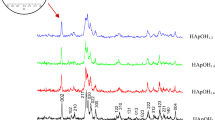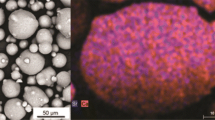Abstract
Calcium phosphate materials synthesized from apatite with atomic Ca/P ratios ranging from 1.50 to 1.67 (Ca10-x(HPO4)x(PO4)6-x(OH)2-x (0 ≤ x ≤ 1)) have very interesting applications in bone regeneration and in the environment field for the removal of toxic species. The physicochemical characteristics of synthetic calcium apatite change when the Ca/P ratio varies. In this study, two batches of apatite powder were prepared by precipitation in an aqueous medium at 25 °C with Ca/P molar ratios that were close to those of tricalcium phosphate (1.48, 1.50, and 1.52) and close to those of hydroxyapatite (1.65, 1.67, and 1.72). For dried and ceramized powders, the chemical composition, morphology, surface area, compacity, durability, and crystalline phases of prepared powders were studied. The result shows that the dried powders composed of nanocrystals are poorly crystallized. The sample with the lowest Ca/P atomic ratio (1.48) shows the lowest specific surface area (75 ± 5 m2/g) with good compaction ability and acceptable mechanical properties. While stoichiometric HAP (Ca/P = 1.67) has a large specific area (110 ± 5 m2/g), however, it has poor compaction properties. Calcined apatite (Ca/P = 1.65) at 900 °C composed of HAP with traces of tricalcium phosphate (Ca3(PO4)2: βTCP) shows a higher compressive strength (78 ± 10 MPa). βTCP ceramic with Ca/P = 1.48 has the lowest optical gap (OG = 4.6 ± 0.4 eV). The result of this study shows how little changes in the Ca/P ratio had an impact on the granular properties of dried and calcined calcium phosphate materials. Apatite produced with slightly sub-stoichiometric calcium has the potential for promising future uses in the biological, catalytic, and environmental domains.






Similar content being viewed by others
Data availability
The authors certify that all data and material claims conform to field standards.
References
Hilbrig, F., Freitag, R.: Isolation and purification of recombinant proteins, antibodies and plasmid DNA with hydroxyapatite chromatography. Biotechnol. J. 7(1), 90–102 (2012). https://doi.org/10.1002/biot.201100015
Nijhawan, A., Butler, E.C., Sabatini, D.A.: Hydroxyapatite ceramic adsorbents: effect of pore size, regeneration, and selectivity for fluoride. J. Environ. Eng. 144(11), 1–7 (2018). https://doi.org/10.1061/(asce)ee.1943-7870.0001464
Stošić, D., Bennici, S., Sirotin, S., Calais, C., Couturier, J.L., Dubois, J.L., Travert, A., Auroux, A.: Glycerol dehydration over calcium phosphate catalysts: effect of acidic-basic features on catalytic performance. Appl. Catal. A 447–448, 124–134 (2012). https://doi.org/10.1016/j.apcata.2012.09.029
Tagaya, M., Ikoma, T., Hanagata, N., Chakarov, D., Kasemo, B., Tanaka, J.: Reusable hydroxyapatite nanocrystal sensors for protein adsorption. Sci. Technol. Adv. Mater. 11(4) (2010). https://doi.org/10.1088/1468-6996/11/4/045002
Dorozhkin, S.V.: Dental applications of calcium orthophosphates (CaPO4). J. Dent. Res 1(2), 1007 (2019)
Ezzahmouly, M., Essakhi, A., El Ouahli, A., El Byad, H., Ed-dhahraouy, M., Hakim, S., Gourri, E., ELmoutaouakkil, A., Hatim, Z.: Automatic computation of bone defective volume from tomographic images. Heliyon 8(6), e09594 (2022). https://doi.org/10.1016/j.heliyon.2022.e09594
Hench, L.L.: Bioceramics: from concept to clinic. J. Am. Ceram. Soc. 74(7), 1487–1510 (1991)
Elouahli, A., Zbair, M., Anfar, Z., Ahsaine, H.A., Khallok, H., Chourak, R., Hatim, Z.: Apatitic tricalcium phosphate powder: high sorption capacity of hexavalent chromium removal. Surf. Interf. 13, 139–147 (2018). https://doi.org/10.1016/j.surfin.2018.09.006
Ibrahim, M., Labaki, M., Giraudon, J.M., Lamonier, J.F.: Hydroxyapatite, a multifunctional material for air, water and soil pollution control: a review. J. Hazard. Mater. 383(May 2019), 121139 (2020). https://doi.org/10.1016/j.jhazmat.2019.121139
Khairnar, R.S., Mene, R.U., Munde, S.G., Mahabole, M.P.: Nano-hydroxyapatite thick film gas sensors. AIP Conf. Proc. 1415(1), 189–192 (2011)
Khallok, H., Elouahli, A., Ojala, S., Keiski, R.L., Kheribech, A., Hatim, Z.: Preparation of biphasic hydroxyapatite/ β-tricalcium phosphate foam using the replication technique. Ceram. Int. 46(14), 22581–22591 (2020). https://doi.org/10.1016/j.ceramint.2020.06.019
Sánchez-Paniagua López, M., Redondo-Gómez, E., López-Ruiz, B.: Electrochemical enzyme biosensors based on calcium phosphate materials for tyramine detection in food samples. Talanta 175(July), 209–216 (2017). https://doi.org/10.1016/j.talanta.2017.07.033
Liguo, M., Yanrong, S., Donglai, L., W, L.: Structure and effect of hydroxyapatite support as well as application in catalyst preparation. J. Chin. Ceram. Soc. 47(12), 1808–1817 (2019)
Pang, S., An, H., Zhao, X., Wang, Y.: Influence of Ca/P ratio on the catalytic performance of hydroxyapatite for decarboxylation of itaconic acid to methacrylic acid. Chin. J. Chem. Eng. 53, 402–408 (2023). https://doi.org/10.1016/j.cjche.2022.01.012
Tsuchida, T., Kubo, J., Yoshioka, T., Sakuma, S., Takeguchi, T., Ueda, W.: Reaction of ethanol over hydroxyapatite affected by Ca/P ratio of catalyst. J. Catal. 259(2), 183–189 (2008). https://doi.org/10.1016/j.jcat.2008.08.005
Bohner, M.: Resorbable biomaterials as bone graft substitutes. Mater. Today 13(1–2), 24–30 (2010). https://doi.org/10.1016/S1369-7021(10)70014-6
Eggli, P.S., Moller, W., Schenk, R.K.: Porous hydroxyapatite and tricalcium phosphate cylinders with two different pore size ranges implanted in the cancellous bone of rabbits: a comparative histomorphometric and histologic study of bony ingrowth and implant substitution. Clin. Orthop. Relat. Res.® 232, 127–138 (1988)
Bohner, M., Santoni, B.L.G., Döbelin, N.: β-tricalcium phosphate for bone substitution: synthesis and properties. Acta Biomater. 113, 23–41 (2020). https://doi.org/10.1016/j.actbio.2020.06.022
LeGeros, R.Z., Lin, S., Rohanizadeh, R., Mijares, D., LeGeros, J.P.: Biphasic calcium phosphate bioceramics: preparation, properties and applications. J. Mater. Sci. Mater. Med. 14(3), 201–209 (2003)
Zou, C., Cheng, K., Weng, W., Song, C., Du, P., Shen, G., Han, G.: Characterization and dissolution–reprecipitation behavior of biphasic tricalcium phosphate powders. J. Alloy. Compd. 509(24), 6852–6858 (2011)
Daculsi, G., Baroth, S., LeGeros, R.: 20 years of biphasic calcium phosphate bioceramics development and applications. 45–58 (2010). https://doi.org/10.1002/9780470584354.ch5
Dorozhkin, S. V.: Calcium orthophosphate (CaPO4)-based bioceramics: preparation, properties, and applications. Coatings 12(10) (2022). https://doi.org/10.3390/coatings12101380
Layrolle, P., Ito, A., Tateishi, T.: Sol-gel synthesis of amorphous calcium phosphate and sintering into microporous hydroxyapatite bioceramics. J. Am. Ceram. Soc. 81(6), 1421–1428 (1998)
Miramond, T., Borget, P., Baroth, S., Daculsi, G.: Comparative critical study of commercial calcium phosphate bone substitutes in terms of physic-chemical properties. Key Eng. Mater. 587, 63–68 (2014). https://doi.org/10.4028/www.scientific.net/KEM.587.63
Santoni, B.L.G., Niggli, L., Dolder, S., Loeffel, O., Sblendorio, G.A., Heuberger, R., Maazouz, Y., Stähli, C., Döbelin, N., Bowen, P., et al.: Effect of minor amounts of $β$-calcium pyrophosphate and hydroxyapatite on the physico-chemical properties and osteoclastic resorption of $β$-tricalcium phosphate cylinders. Bioactive Mater. 10, 222–235 (2022)
Descamps, M., Hornez, J.C., Leriche, A.: Effects of powder stoichiometry on the sintering of β-tricalcium phosphate. J. Eur. Ceram. Soc. 27(6), 2401–2406 (2007). https://doi.org/10.1016/j.jeurceramsoc.2006.09.005
Ryu, H.S., Youn, H.J., Sun Hong, K., Chang, B.S., Lee, C.K., Chung, S.S.: An improvement in sintering property of β-tricalcium phosphate by addition of calcium pyrophosphate. Biomaterials 23(3), 909–914 (2002). https://doi.org/10.1016/S0142-9612(01)00201-0
Sun, J.S., Huang, Y.C., Lin, F.H., Chen, L.T.: The effect of sintered dicalcium pyrophosphate on osteoclast metabolism: an ultrastructural study. J. Biomed. Mater. Res. Part A 64(4), 616–621 (2003). https://doi.org/10.1002/jbm.a.10439
Abida, F.: Valorisation de l’acide orthophosphorique produit au Maroc par la préparation de poudre d’hydroxyapatite et de pièces céramiques à usage médical. PhD Thesis , University Chouaib Doukkali Morocco. (2010)
El Ouahli, A., Khallok, H., Hatim, Z.: Neutralization method for tricalcium phosphate production: optimization using response surface methodology. Surf. Interf. 15(February), 100–109 (2019). https://doi.org/10.1016/j.surfin.2019.02.007
Patrycja, M., Michał, P., Wojciech, M.: How to correctly determine the band gap energy of modified semiconductor photocatalysts based on UV–vis spectra. J. Phys. Chem. Lett. 9(23), 6814–6817 (2018). https://doi.org/10.1021/acs.jpclett.8b02892
Tauc, J., Grigorovici, R., Vancu, A.: Optical properties and electronic structure of amorphous germanium. Phys. Status Solidi B 15, 627–637 (1966)
Raynaud, S., Champion, E., Bernache-Assollant, D.: Calcium phosphate apatites with variable Ca/P atomic ratio II. Calcination and sintering. Biomaterials 23(4), 1073–1080 (2002). https://doi.org/10.1016/S0142-9612(01)00219-8
Tampieri, A., Celotti, G., Szontagh, F., Landi, E.: Sintering and characterization of HA and TCP bioceramics with control of their strength and phase purity. J. Mater. Sci. Mater. Med. 8(1), 29–37 (1997). https://doi.org/10.1023/A:1018538212328
Destainville, A., Champion, E., Bernache-Assollant, D., Laborde, E.: Synthesis, characterization and thermal behavior of apatitic tricalcium phosphate. Mater. Chem. Phys. 80(1), 269–277 (2003). https://doi.org/10.1016/S0254-0584(02)00466-2
Ślósarczyk, A., Piekarczyk, J.: Ceramic materials on the basis of hydroxyapatite and tricalcium phosphate. Ceram. Int. 25(6), 561–565 (1999). https://doi.org/10.1016/S0272-8842(98)00019-4
Bensaoud, A., Bouhaouss, A., Ferhat, M.: Electrical properties in compressed poorly crystalline apatite. J. Solid State Electrochem. 5(5), 362–365 (2001). https://doi.org/10.1007/s100080000154
Fanovich, M.A., Castro, M.S., Lopez, J.M.P.: Analysis of the microstructural evolution in hydroxyapatite ceramics by electrical characterisation. Ceram. Int. 25(6), 517–522 (1999)
Mahabole, M.P., Aiyer, R.C., Ramakrishna, C.V., Sreedhar, B., Khairnar, R.S.: Synthesis, characterization and gas sensing property of hydroxyapatite ceramic. Bull. Mater. Sci. 28(6), 535–545 (2005). https://doi.org/10.1007/BF02706339
Valdes, J.J.P., Rodriguez, A.V., Carrio, J.G.: Dielectric properties and structure of hydroxyapatite ceramics sintered by different conditions. 10(9) (1995).
Tanaka, Y., Takata, S., Shimoe, K., Nakamura, M., Nagai, A., Toyama, T., Yamashita, K.: Conduction properties of non-stoichiometric hydroxyapatite whiskers for biomedical use. J. Ceram. Soc. Jpn. 116(1355). https://doi.org/10.2109/jcersj2.116.815
Author information
Authors and Affiliations
Contributions
All authors contributed to the study conception and design. Material preparation, data collection, and analysis were performed by Anas Hatim, Fatima Abida, Abdelaziz Elouahli, Abdelkrim Abourriche, Abdelaziz Benhammou, Youssef El Hafiane, Bouchaib Gourich, Zineb Hatim, Agnès Smith, and Younes Abouliatim. The first draft of the manuscript was written by Anas Hatim and all authors commented on previous versions of the manuscript. All authors read and approved the final manuscript.
Corresponding author
Ethics declarations
Ethical approval
The authors approve the journal’s ethics policy.
Consent to participate
The authors consent to the participation of this work.
Consent for publication
The authors consent to publication.
Competing interests
The authors declare no competing interests.
Additional information
Publisher's note
Springer Nature remains neutral with regard to jurisdictional claims in published maps and institutional affiliations.
Rights and permissions
Springer Nature or its licensor (e.g. a society or other partner) holds exclusive rights to this article under a publishing agreement with the author(s) or other rightsholder(s); author self-archiving of the accepted manuscript version of this article is solely governed by the terms of such publishing agreement and applicable law.
About this article
Cite this article
Hatim, A., Abida, F., Elouahli, A. et al. Physico-chemical characterization of calcium-apatite prepared with a calcium/phosphate ratio around the stoichiometry. J Aust Ceram Soc 60, 221–230 (2024). https://doi.org/10.1007/s41779-023-00935-2
Received:
Revised:
Accepted:
Published:
Issue Date:
DOI: https://doi.org/10.1007/s41779-023-00935-2




